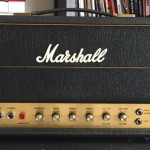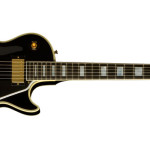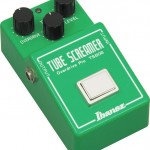 If only things were so easy that we could buy the guitar we felt comfortable with, plug into an amp, maybe add a pedal or two, and then be done. Tone Nirvana. It usually doesn’t happen this way however. The problem is that there are numerous choices for gear and, and even more options for putting together the whole rig, to create an effective system that is optimized. And just how we use the equipment (whether for live use or studio recording) also makes a difference in finding what works for guitarists.
If only things were so easy that we could buy the guitar we felt comfortable with, plug into an amp, maybe add a pedal or two, and then be done. Tone Nirvana. It usually doesn’t happen this way however. The problem is that there are numerous choices for gear and, and even more options for putting together the whole rig, to create an effective system that is optimized. And just how we use the equipment (whether for live use or studio recording) also makes a difference in finding what works for guitarists.
We recently wrote about the challenges with the Internet and its opinions. You can find as many people who will love or hate any particular piece of gear. This can become frustrating when trying to dial in a tone you’re interested in capturing.
Some people use the approach of buying the gear that their favorite artists use. That can be o.k. in some cases, but we need to keep in mind a couple of things. 1) Make sure the artist actually uses the piece of gear and just isn’t being paid simply to endorse it, and 2) Recognize that professional artists making studio albums will get a different sound on recordings – especially if they have the benefits of big budget studio equipment that turn out great final mixes and masters.
So what do I suggest? I think starting with a reference artist is still a good thing to spend time studying. We’ve done a few profiles here on LegendaryTones of a few classic artists and will look to do more in the future.
But from a gear perspective, and especially for when it comes to distorted tones, let’s first think about the guitar in context of a band. The guitar’s frequencies are dominant in the midrange of tone. The highs in a guitar won’t and can’t compete with the sounds produced by the drums and cymbals, nor will the bottom end frequencies of a guitar be able to compete with the powerful sound spectrum produced by a bass. Those guitar players going for a “mid-scooped” sound, which may sound awesome in their bedrooms, will often sound quite thin when placed amongst other instruments in a live setting since the primary midrange frequencies are naturally being reduced. Mid-scooping is essentially cutting the volume of the midrange of your guitar…even though those are the most important and primary frequencies of your instrument.
So how do we fix this? It’s more than just working the eq knobs to get things dialed in. Understanding the general tonal characteristics of your key pieces of gear will help. Now what exactly do I mean by “general tonal characteristics”?
Guitars
Let’s discuss a few classic examples of guitars first. A Fender vs. a Gibson is the obvious first area to consider. Fenders with single coil pickups have a distinct clarity of notes from lows to highs, but overall have a somewhat mid-scooped tone. They’ll have lower output, but nice and percussive qualities with emphasis on the top end. The pay-off with single-coil Stratocasters is a beautiful and percussive attack and great note definition and clarity.
 A typical Gibson on the other hand has higher-output humbucking pickups and a stronger low-end and midrange focus. While the pickup certainly can be equalized for different response characteristics depending on how it is wound and built, overall even when you play a Gibson Les Paul acoustically without plugging in, you can hear the resonance of the instrument that is fuller in tone when compared with a Fender Stratocaster. Gibsons have a thicker natural tonality, which is beneficial for a number of genres. The body woods, construction, and scale length differences between each guitar all matter.
A typical Gibson on the other hand has higher-output humbucking pickups and a stronger low-end and midrange focus. While the pickup certainly can be equalized for different response characteristics depending on how it is wound and built, overall even when you play a Gibson Les Paul acoustically without plugging in, you can hear the resonance of the instrument that is fuller in tone when compared with a Fender Stratocaster. Gibsons have a thicker natural tonality, which is beneficial for a number of genres. The body woods, construction, and scale length differences between each guitar all matter.
Amps
Amps also have characteristic tones and the point of this post isn’t to attempt to cover them all in detail. But if we look at a few of the classics, from Fender, Marshall, and Vox, they each have a certain sonic signature.
Similar to Fender guitars, the popular blackface lineup of Fender amps tends to be clean and carries an emphasis on the high-mids and treble. Some models can put out more low end, depending on the speaker configuration and power output, but let’s just say that in general, a Fender amp is not known to typically have a lot of key midrange available.
What this provides is a glassy enhancement to other Fender instruments that plug  into Fender amps. This is a bright configuration that can cut through the mix, but is still generally thin. Fender’s have a moderate amount of distortion available, though one has to be careful with the treble emphasis and often also should stay away from use of any amp bright switches when going for the overdriven effects.
into Fender amps. This is a bright configuration that can cut through the mix, but is still generally thin. Fender’s have a moderate amount of distortion available, though one has to be careful with the treble emphasis and often also should stay away from use of any amp bright switches when going for the overdriven effects.
A Marshall, although like Fender with numerous models available, generally has its tonal base shaped around the key midrange frequencies of the guitar. A Marshall is typically bright and has top-end emphasis but most importantly can fill the midrange gap beautifully for rock and roll sounds. This is why a Marshall has been the sound of rock for decades.
 The earliest non-master volume Marshall models can even provide additional fattening of the low-end frequencies by way of the tube compression as well as through mild speaker distortion. The magic of these Marshalls in getting that full balance of tone is through turning up the volume. That’s not always so practical!
The earliest non-master volume Marshall models can even provide additional fattening of the low-end frequencies by way of the tube compression as well as through mild speaker distortion. The magic of these Marshalls in getting that full balance of tone is through turning up the volume. That’s not always so practical!
There are plenty of Fender and Marshall amps made these days that both attempt to bridge the gap and are eq’d to provide more lows and mids at more reasonable volumes. The bottomline is to listen to the amp you’re auditioning and understand that midrange is your friend – you sometimes just need to simply let your ears adjust to new sounds.
The Vox amplifier is an interesting mixture of tones. It has its own midrange tonality but with a top end sparkle that neither a Fender or Marshall exhibits. The distortion from a Vox is also somewhere between a Fender and Marshall as well – with more dirt on tap than a Fender, but not nearly as saturated as a Marshall. This gives the Vox a unique voice and clarity that players love.
A Vox is configured in such a way to where the tubes are in Class A configuration. Not very efficient and always running hot. It contributes greatly to the sound a Vox produces.
Overdrive and Distortion Effects and Bringing the Ingredients Together
Adding effects to the mix can dramatically shape the tone you’re seeking as well as assist with the overall available gain. Again, there are multitudes of different overdrive and distortion choices and of course the Internet is filled with varying opinions.
The approach I suggest is to use a “system approach” when mixing overdrives and distortions with your amps and guitars. This is also an area where looking at those famous players that came before us can really help guide your own approach.
For example, if we think of Strat players that have fat, thick tones that cut through the mix, but still retain that Fender tonality, we must look at the late, great Stevie Ray  Vaughan. While he played an assortment of gear, he was most commonly associated with a Fender Super Reverb (4×10 speakers in a 40 watt combo), a Stratocaster, and a Tube Screamer. The Fender on Fender tones are naturally thinner, so it was the Tube Screamer which served both as a boost for more overdrive as well as an e.q. shaper of mids. This really helped SRV achieve his tone. We can’t overlook the fingers and his incredibly playing technique, but that Tube Screamer overdrive also was pivotal in helping bring the Strat tone out in front with its added midrange punch.
Vaughan. While he played an assortment of gear, he was most commonly associated with a Fender Super Reverb (4×10 speakers in a 40 watt combo), a Stratocaster, and a Tube Screamer. The Fender on Fender tones are naturally thinner, so it was the Tube Screamer which served both as a boost for more overdrive as well as an e.q. shaper of mids. This really helped SRV achieve his tone. We can’t overlook the fingers and his incredibly playing technique, but that Tube Screamer overdrive also was pivotal in helping bring the Strat tone out in front with its added midrange punch.
Essentially the Tube Screamer compensated for the lack of midrange in both the Strat and Fender amp, so in this application, the Tube Screamer is ideal.
Always consider the environment your overdrive or distortion pedal will be used in to maximize its impact. Today’s pedals often have a very full-range available in their distortion characteristics, which enable them to be a good platform of choice when used against a clean amp. Still, many people strongly prefer the interaction of distortion that occurs from the preamp and output stages of a tube amplifier – myself included. That said, adding a little bit of distortion or overdrive can be just what the doctor ordered when playing an older amp that could use some additional gain.
Even modern amps that have enough gain onboard are often boosted for different tones and feel. Mesa Rectifiers can do well by using a clean boost or light overdrive to push the gain stage, which gives the effect of tightening up the overall gain stages. However, a Mesa Rectifier in and of itself does not commonly need “more” gain.
Last Tips
When setting your controls, what works in the bedroom will often NOT work when playing live in the context of a band. We’ve talked about the topic, but it bears repeating – always consider eq changes based on the volume you are using. As the volume goes up, often the treble and bass need to be turned down to compensate. Our ears are sensitive and will respond as such with volume. And lastly, don’t worry about the actual position of the knobs, but instead use your ears. With one guitar I use, I have to turn the mids on my Mesa amp at 0, and there is still plenty of midrange punch available. The tubes, pickups, strings, speakers ALL have an impact on the final tone. If you have a particular configuration that you use that works for you, or if you have general questions, please feel free to leave a comment below!